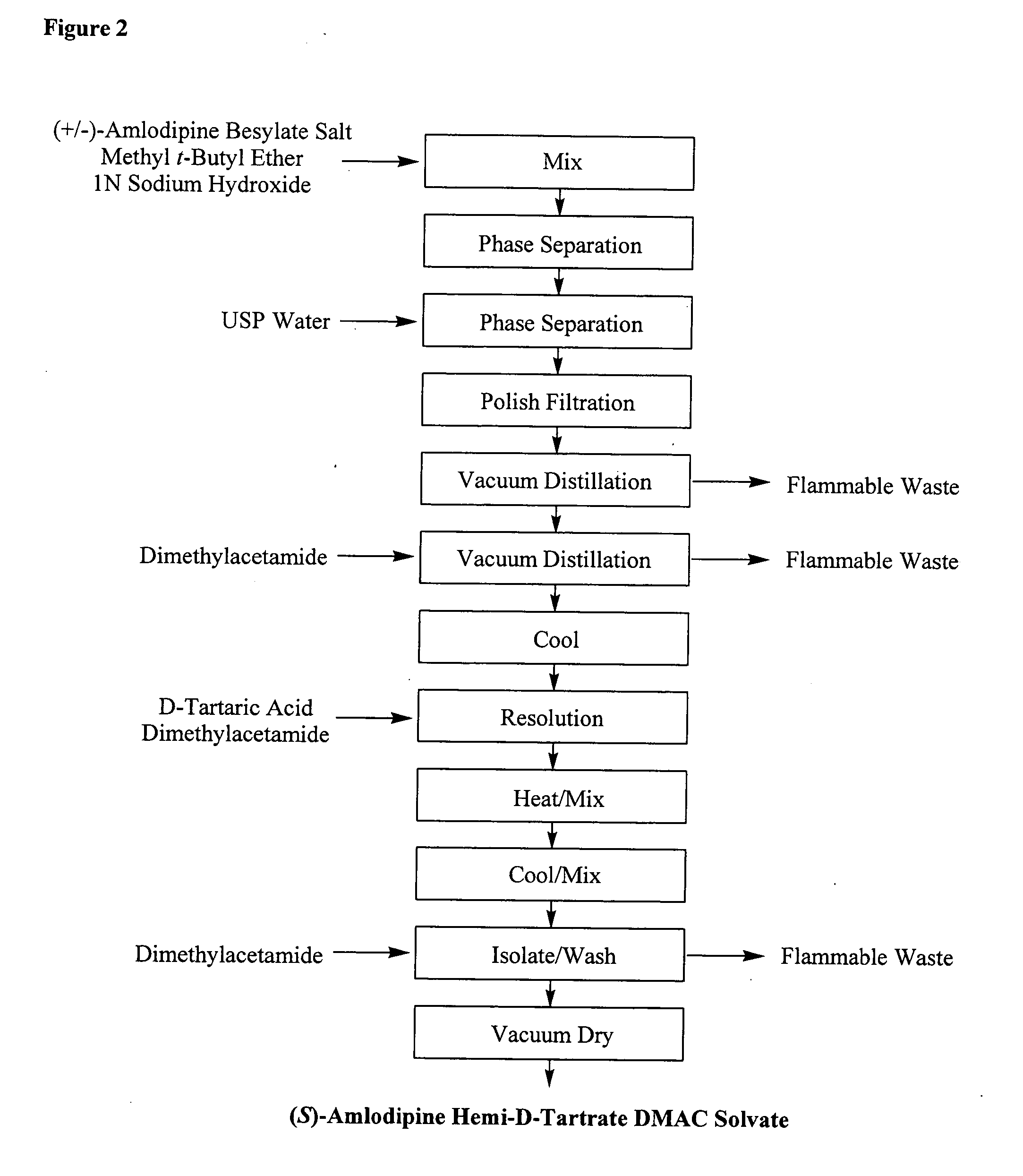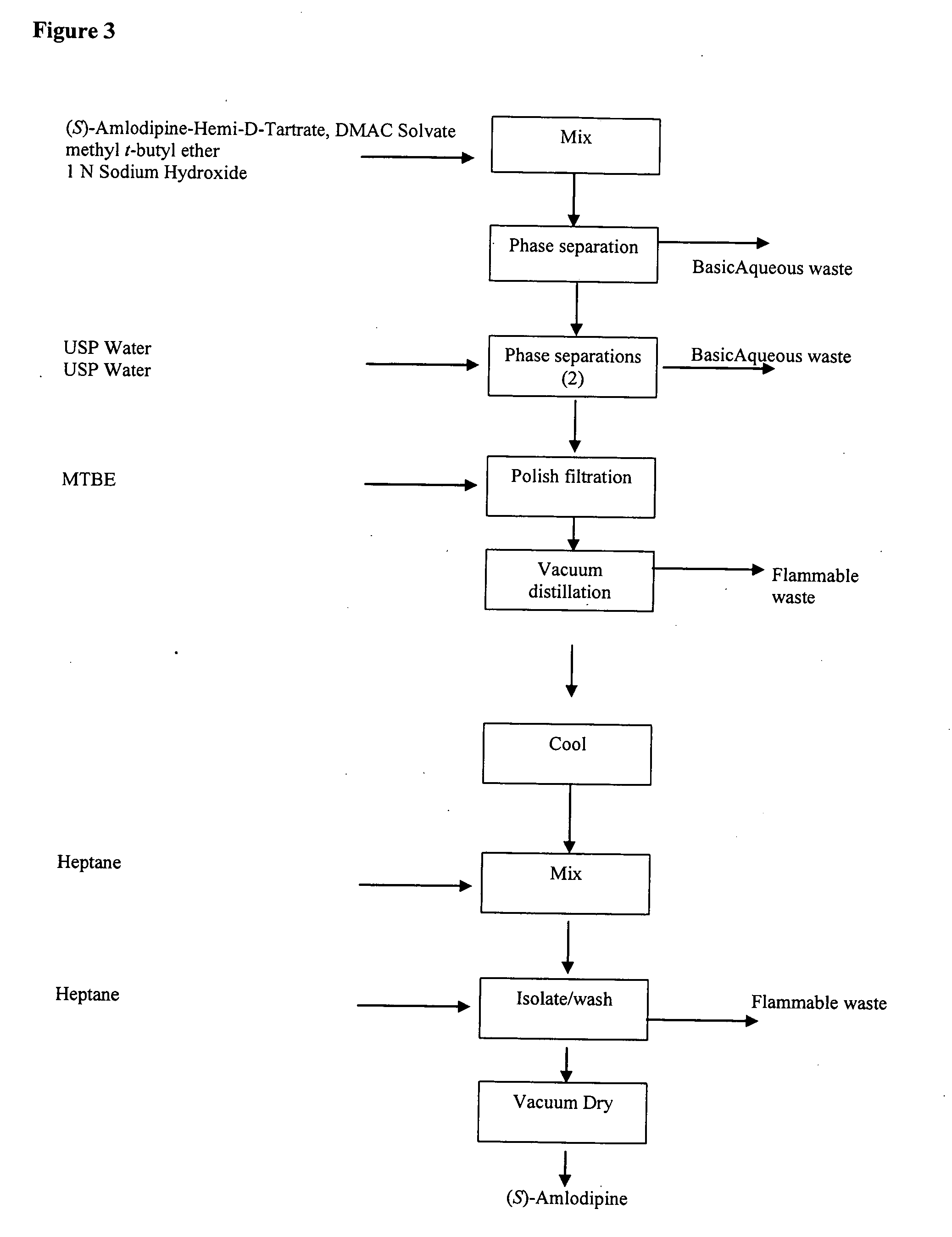(S)-amlodipine malate
a technology of amlodipine malate and amlodipine maleate, which is applied in the direction of biocide, drug composition, cardiovascular disorder, etc., can solve the problems of amlodipine malate being a sticky material, and reducing systolic and diastolic blood pressur
- Summary
- Abstract
- Description
- Claims
- Application Information
AI Technical Summary
Problems solved by technology
Method used
Image
Examples
example 1
Process Description for (S)-Amlodipine Hemi-D-Tartrate DMAC Solvate from (RS)-Amlodipine Besylate
[0338]
[0339] (RS)-Amlodipine besylate (49.8 kg) and methyl t-butyl ether (MTBE) (240 kg) were charged to a 200 gal reactor, followed by the addition of aqueous 1 N sodium hydroxide (137 kg). The mixture was agitated for 20 to 30 minutes and then the layers were allowed to separate for a minimum of 15 minutes. The aqueous layer was removed and the organic layer was washed twice with water (about 66 kg each). The organic layer was polish filtered and concentrated under vacuum (at not more than about 50° C.) to about 109 L. N,N-Dimethylacetamide (DMAC, 153 kg) was charged to the reactor and the solution was again concentrated under vacuum until the batch temperature reached 45 to 55° C. The final volume was about 208 L. The reaction was cooled to 20 to 25° C., followed by the addition of a D-tartaric acid solution (14 kg of D-tartaric acid in about 153 kg of DMAC) over 20 to 30 minutes. Th...
example 2
Process Description for (S)-Amlodpine-hemi-D-Tartrate DMAC Solvate From (RS)-Amlodipine Free Base
[0341]
[0342] A solution of D-tartaric acid (9.5 kg, 63.2 moles) in DMAC (104 kg) was added to a slurry of (RS)-amlodipine free-base (25 kg, 61 moles) in DMAC (104 kg). The reaction mixture was agitated and heated to about 70° C. The reaction mass was held for about one hour with agitation at about 70° C. The resulting slurry was then cooled with agitation to about 22° C. over 2.5 to 3 hours (cooling profile was about 0.3° C. / min). The slurry was held with agitation at about 22° C. for about 0.5 hr. The solid was isolated by filtration, washed by re-slurrying with DMAC followed by a displacement wash with MTBE. The wet cake was vacuum dried at about 45° C. to produce (S)-Amlodipine-hemi-D-Tartrate-DMAC solvate (13.9 kg, 99.8% chemical purity, 99.2% ee).
example 3
Process Description for (S)-Amlodipine Free Base From (S)-Amlodipine Hemi-D-Tartrate DMAC Solvate
[0343]
[0344] (S)-Amlodipine hemi-D-tartrate DMAC solvate (30 kg) and MTBE (about 245 kg) were charged to a 200 gal reactor. The temperature was adjusted to 20 to 25° C., followed by the addition of 1 N sodium hydroxide (about 86 kg) while maintaining a temperature of 20 to 25° C. The reaction was stirred for about 30 minutes and then the layers were allowed to separate. The bottom aqueous layer was removed, and the organic layer was washed twice with water (about 82 kg each wash). The solution was filtered through a polishing filter, followed by a reactor and line rinse of MTBE (about 45 kg). The solution was distilled to about 87 L under vacuum Oacket temperature not more than about 40° C.) and the mixture was cooled to 20 to 25° C. Heptane (about 80 kg) was charged over about 60 minutes and the reaction was agitated at 20 to 25° C. for about 60 minutes. The slurry was filtered and was...
PUM
| Property | Measurement | Unit |
|---|---|---|
| enantiomeric excess | aaaaa | aaaaa |
| enantiomeric excess | aaaaa | aaaaa |
| enantiomeric excess | aaaaa | aaaaa |
Abstract
Description
Claims
Application Information
 Login to View More
Login to View More - R&D
- Intellectual Property
- Life Sciences
- Materials
- Tech Scout
- Unparalleled Data Quality
- Higher Quality Content
- 60% Fewer Hallucinations
Browse by: Latest US Patents, China's latest patents, Technical Efficacy Thesaurus, Application Domain, Technology Topic, Popular Technical Reports.
© 2025 PatSnap. All rights reserved.Legal|Privacy policy|Modern Slavery Act Transparency Statement|Sitemap|About US| Contact US: help@patsnap.com



